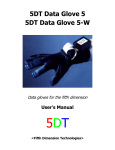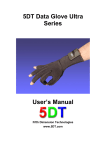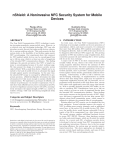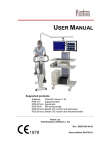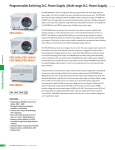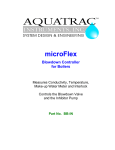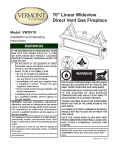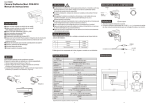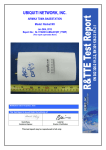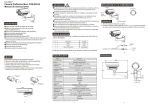Download The 5DT Data Glove Driver
Transcript
The 5DT Data Glove Driver Reference Manual 5DT Version 1.00 January 2000 Table of Contents 1. INTRODUCTION..................................................................................................................... 1 2. USING THE GLOVE DRIVER ............................................................................................... 1 2.1 WINDOWS 95/98/NT.......................................................................................................... 1 2.2 LINUX ................................................................................................................................. 1 2.2.2 SETTING UP ACCESS TO THE SERIAL PORT......................................................... 2 2.2.3 THE HEADER FILE ....................................................................................................... 2 2.3 SAMPLE SOURCE CODE ................................................................................................ 2 3. SUPPORTED GLOVES ........................................................................................................... 3 3.1 SENSOR MAPPINGS FOR THE 5DT DATA GLOVE 5................................................. 3 3.2 SENSOR MAPPINGS FOR THE 5DT DATA GLOVE 16............................................... 4 4. FUNCTION REFERENCE ...................................................................................................... 5 5. GESTURE DEFINITIONS..................................................................................................... 16 6. AUTO-CALIBRATION ......................................................................................................... 19 1. Introduction The 5DT Data Glove Driver provides access to the 5DT range of data gloves at an intermediate level. The Windows 95/98/NT version is provided in the form of a C/C++ header (.h) file, a Microsoft Visual C++ library (.lib) file and a dynamic link library (.dll) file. The Linux version is provided in form of a C/C++ header (.h) file, and a dynamic library (.so) file. The driver functionality includes: • • • • • • • Multiple instances Easy initialization and shutdown Basic (raw) sensor values Scaled (auto-calibrated) sensor values Calibration functions Basic gesture recognition Cross-Platform Application Programming Interface 2. Using the glove driver The 5DT Data Glove Driver is easy to implement. Use the following guidelines: 2.1 Windows 95/98/NT i. Make sure that the header file fglove.h, the library file fglove.lib and the dynamic link library file fglove.dll reside in the current (application) directory, or somewhere that they can be found. The file fglove.dll may be copied into your Windows system directory. ii. Include the header file fglove.h in the application where necessary. iii. Add the library file fglove.lib to the link process. There is a also a debug version of the driver (fgloved.lib, fgloved.dll) which outputs debug messages to the debugger. 2.2 Linux The driver requires the Linux Posix threads library libpthread.so, which is usually installed with Linux. The driver is linked to libc6. 2.2.1 Installing the library The driver is a dynamic library file (libfglove.so) which must be installed somewhere where applications can find it. If you have root access to the system, the easiest method is to copy the file into the /usr/lib directory, e.g.: 1 # cp libfglove.so /usr/lib If you do not have root access to the system, you should place the library somewhere in your home directory, and then set the LD_LIBRARY_PATH environment variable to include the full path of the directory in which you have placed the library. This will indicate to the dynamic library loader where to find the file. For example: $ mkdir /home/yourhomedir/libs $ cp libfglove.so /home/yourhomedir/libs $ export LD_LIBRARY_PATH="/home/yourhomedir/libs" In the above example, replace "yourhomedir" with your own home directory name. 2.2.2 Setting up access to the serial port The 5DT Data Glove accesses the serial port using the standard Unix/Linux device files in the /dev directory. Applications that use the glove should typically give the user the option of specifying which device to check, such as /dev/ttyS1. It is recommended that you create a symbolic link /dev/fglove to your device file, e.g: # cd /dev # ln -s ttyS1 fglove This may make the setup of applications easier should you need to change the port that the glove is connected to. It is also required that the user of the glove has read/write access to the serial port device file. By default, normally only the root user has these rights. If non-root users on the system will be using the glove, the root user must grant access rights to the device file. For example, the following command will give everyone on the system full access to the serial port /dev/ttyS1: # chmod 777 /dev/ttyS1 2.2.3 The header file The header file (fglove.h) should be copied somewhere where your compiler can find it. If you have root access, the easiest is to copy it to /usr/include. If not, then just place the header file in the same directory as your application. 2.3 Sample source code Sample source code that makes use of the glove driver is distributed with the driver. 2 3. Supported gloves The glove driver supports all 5DT Data Gloves. The current version implements 18 possible sensors, and includes the roll and pitch sensors of the original 5DT Data Glove 5. The driver attempts to map values to all sensor outputs. If it is unable to do so the sensor value defaults to a sensible value. This value can be adjusted by forcing a specific value. To the application programmer the driver therefore appears the same regardless of the type of glove that is connected. 3.1 Sensor mappings for the 5DT Data Glove 5 The sensors on the 5DT Data Glove 5 are positioned as in Fig. 1. E D C F B G Top of hand Right handed glove A Tilt sensor Figure 1 - Sensor positions for the 5DT Data Glove 5 Sensor A B C D E F G Driver Sensor Index 0,1* 3,4* 6,7* 9,10* 12,13* 16 17 Description Thumb flexure Index finger flexure Middle finger flexure Ring finger flexure Little finger flexure Pitch angle of tilt sensor Roll angle of tilt sensor Table 1 - Sensor mappings for 5DT Data Glove 5 * Both these driver sensor indices will return the same value when the 5DT Data Glove 5 is used. 3 3.2 Sensor mappings for the 5DT Data Glove 16 The sensors on the 5DT Data Glove 16 are positioned as in Fig. 2 13 10 12 9 11 15 8 7 6 5 4 3 14 2 0 Top of hand Right handed glove 1 Figure 2 - Sensor mappings for the 5DT Data Glove 16 Sensor 0 1 2 3 4 5 6 7 8 9 10 11 12 13 14 15 Driver Sensor Index 0 1 2 3 4 5 6 7 8 9 10 11 12 13 14 15 Description Thumb flexure ( lower joint ) Thumb flexure ( second joint ) Thumb-index finger abduction Index finger flexure ( at knuckle ) Index finger flexure ( second joint ) Index-middle finger abduction Middle finger flexure ( at knuckle ) Middle finger flexure ( second joint ) Middle-ring finger abduction Ring finger flexure ( at knuckle ) Ring finger flexure ( second joint ) Ring-little finger abduction Little finger flexure ( at knuckle ) Little finger flexure ( second joint ) Thumb translation [not yet implemented] Wrist flexure [not yet implemented] Table 2 - Sensor mappings for 5DT Data Glove 16 4 4. Function reference The following functions are provided by the driver: ______________________________________________________________ fdGlove *fdOpen(char *pPort) Initializes the glove device on the specified port. Return value Returns a pointer to the glove device (fdGlove *). NULL is returned if an error occurred. Parameter pPort Pointer to a zero terminated ASCII string containing the name of the communication port. Valid values on Windows range from "COM1" to "COM8". Unix/Linux port names will differ. Remarks Do not attempt to alter the contents of the returned pointer directly, use the functions provided instead. ______________________________________________________________ int fdClose(fdGlove *pFG) Frees the glove device and communications port. Return value Returns nonzero if successful, zero if an error occurred. Parameters pFG Pointer to a glove device. This is the value returned by fdOpen(). Remarks It is important to call this function when you are finished using the glove. ______________________________________________________________ int fdGetGloveHand(fdGlove *pFG) Obtains the handedness (left or right handed) of the glove. Return value Returns either FD_HAND_LEFT or FD_HAND_RIGHT, as defined by the enumerated type EfdGloveHand. Parameters pFG Pointer to a glove device. This is the value returned by fdOpen(). Remarks None. 5 ______________________________________________________________ int fdGetGloveType(fdGlove *pFG) Obtains the type of the currently connected glove. Return value Returns one of FD_GLOVENONE, FD_GLOVE7, FD_GLOVE7W, FD_GLOVE16 or FD_GLOVE16W, as defined by the enumerated type EfdGloveTypes. Parameters pFG Pointer to a glove device. This is the value returned by fdOpen(). Remarks FD_GLOVE7 and FD_GLOVE7W refer to the original 5+2 (tilt angles) sensor glove (5DT Data Glove 5). The W suffix indicates a wireless model. FD_GLOVE16 and FD_GLOVE16W refer to the 16 sensor glove. In order to accommodate both glove types the fdGetNumSensors() function currently returns 18 sensors. The additional two sensors are defined as the original tilt angles that are not present in the 16-sensor glove. See the description of fdGetNumSensors()for more details. ______________________________________________________________ int fdGetNumSensors(fdGlove *pFG) Obtains the number of available sensors values the driver can make available. Return value Returns the number of sensors. Currently it is fixed at 18, but future driver releases may differ. Parameters pFG Pointer to a glove device. This is the value returned by fdOpen(). Remarks Although the 5-sensor glove can measure only average flexure, the driver will attempt to fill in missing values. The number of sensors returned can therefore be of a higher dimension. The enumerated type EfdSensors defines the finger mapping for each sensor. ______________________________________________________________ void fdGetSensorRawAll(fdGlove *pFG, unsigned short *pData) Obtains the most recent raw sensor values from the currently connected glove. Return value None. Parameters pFG Pointer to a glove device. This is the value returned by fdOpen(). 6 pData Pointer to an array of 16-bit integers that will contain the raw sensor values. The size of the array must always match the value returned by fdGetNumSensors(). Remarks Currently the raw sensor samples are all 12 bit unsigned values. The range is therefore from 0 to 4095. Note that this is not the dynamic range of the sensors. There can be severe offset values associated with each sensor. The enumerated type EfdSensors defines the finger mapping for each sensor. ______________________________________________________________ unsigned short fdGetSensorRaw(fdGlove *pFG, int nSensor) Obtains the most recent raw sensor value for a specific sensor from the currently connected glove. Return value Returns a 16-bit integer. See fdGetSensorRawAll() for details. Parameters pFG Pointer to a glove device. This is the value returned by fdOpen(). nSensor Index of the sensor that is being set. The value must lie in the range given by the enumerated type EfdSensors, or alternatively from zero to the value returned by fdGetNumSensors() minus one. Remarks The enumerated type EfdSensors defines the finger mapping for each sensor. ______________________________________________________________ void fdSetSensorRawAll(fdGlove *pFG, unsigned short *pData) Forces the raw value for all the sensors. Return value None. Parameters pFG Pointer to a glove device. This is the value returned by fdOpen(). pData Pointer to an array of 16-bit integers that will contain the raw sensor values. The size of the array must always match the value returned by fdGetNumSensors(). Remarks Currently the raw sensor samples are all 12 bit unsigned values. The range is therefore from 0 to 4095. The enumerated type EfdSensors defines the finger mapping for each sensor. Forcing a sensor value will result in a raw and scaled output other than the default zero. Values that can be mapped will be overwritten, rendering the forced value void. 7 ______________________________________________________________ void fdSetSensorRaw(fdGlove *pFG, int nSensor, unsigned short nRaw) Forces the raw value for a specific sensor. Return value None. Parameters pFG Pointer to a glove device. This is the value returned by fdOpen(). nSensor Index of the sensor that is being set. The value must lie in the range given by the enumerated type EfdSensors, or alternatively from zero to the value returned by fdGetNumSensors() minus one. nRaw 16 bit raw value of the sensor. If the sensor is unmapped, the scaling calculations will proceed as normal. Remarks The enumerated type EfdSensors defines the finger mapping for each sensor. This function is only useful for sensors that cannot be mapped by a specific hardware device. Forcing a sensor value will result in a raw and scaled output other than the default zero. Values that can be mapped will be overwritten, rendering the forced value void. ______________________________________________________________ void fdGetSensorScaledAll(fdGlove *pFG, float *pData) Obtains the most recent scaled (auto-calibrated) sensor values from the currently connected glove. Return value None. Parameters pFG Pointer to a glove device. This is the value returned by fdOpen(). pData Pointer to an array of floating point numbers that will contain the scaled sensor values. The size of the array must always match the value returned by fdGetNumSensors(). Remarks The sensor range is a value from zero to the value defined by the fdSetSensorMax() and fdSetSensorMaxAll() functions. The glove driver defaults to a range of [0...1]. The automatic calibration process is described in section 6. The enumerated type EfdSensors defines the finger mapping for each sensor. 8 ______________________________________________________________ float fdGetSensorScaled(fdGlove *pFG, int nSensor) Obtains the most recent scaled (auto-calibrated) value for a specific sensor from the currently connected glove. Return value Returns a floating point sensor value. Parameters pFG Pointer to a glove device. This is the value returned by fdOpen(). nSensor Index of the sensor that is being set. The value must lie in the range given by the enumerated type EfdSensors, or alternatively from zero to the value returned by fdGetNumSensors() minus one. Remarks The sensor range is a value from zero to the value defined by the fdSetSensorMax() and fdSetSensorMaxAll() functions. The glove driver defaults to a range of [0...1]. The automatic calibration process is described in section 6. The enumerated type EfdSensors defines the finger mapping for each sensor. ______________________________________________________________ int fdGetNumGestures(fdGlove *pFG) Obtains the number of available gestures that can be recognized by the glove driver. Return value Returns the number of available gestures. Currently 16 different gestures are supported. Refer to section 5 for details. Parameters pFG Pointer to a glove device. This is the value returned by fdOpen(). Remarks None. ______________________________________________________________ int fdGetGesture(fdGlove *pFG) Obtains the current gesture being performed. Return value Returns the current gesture being performed. Refer to section 5 for details. Parameters pFG Pointer to a glove device. This is the value returned by fdOpen(). 9 Remarks None. ______________________________________________________________ void fdGetCalibrationAll(fdGlove *pFG, unsigned short *pUpper, unsigned short *pLower) Obtains the current auto-calibration settings of the driver. Return value None. Parameters pFG Pointer to a glove device. This is the value returned by fdOpen(). pUpper and pLower Arrays of 16 bit unsigned integers that will contain the maximum and minimum raw sensor values. The size of each array must always match the value returned by fdGetNumSensors(). Refer to section 6 for details. Remarks None. ______________________________________________________________ void fdGetCalibration(fdGlove *pFG, int nSensor, unsigned short *pUpper, unsigned short *pLower) Obtains the current auto-calibration settings of the driver for a specific sensor. Return value None. Parameters pFG Pointer to a glove device. This is the value returned by fdOpen(). nSensor Index of the sensor that is being set. The value must lie in the range given by the enumerated type EfdSensors, or alternatively from zero to the value returned by fdGetNumSensors() minus one. pUpper and pLower Pointers to 16 bit unsigned integers containing the maximum and minimum raw sensor values. Refer to section 6 for details. Remarks None. ______________________________________________________________ void fdSetCalibrationAll(fdGlove *pFG, unsigned short *pUpper, unsigned short *pLower) 10 Resets the current auto-calibration settings of the driver to user defined values. Return value None. Parameters pFG Pointer to a glove device. This is the value returned by fdOpen(). pUpper and pLower Arrays of 16 bit unsigned integers containing the maximum and minimum raw sensor values. The size of each array must always match the value returned by fdGetNumSensors(). Refer to section 6 for details. Remarks For unmapped sensors it would be sensible to set the upper and lower calibration settings above and below the raw value forced with fdSetSensorRaw()and fdSetSensorRawAll(). ______________________________________________________________ void fdSetCalibration(fdGlove *pFG, int nSensor, unsigned short nUpper, unsigned short nLower) Resets the current auto-calibration settings of the driver for a specific sensor to user defined values. Return value None. Parameters pFG Pointer to a glove device. This is the value returned by fdOpen(). nSensor Index of the sensor that is being set. The value must lie in the range given by the enumerated type EfdSensors, or alternatively from zero to the value returned by fdGetNumSensors() minus one. nUpper and nLower 16 bit unsigned integers containing the maximum and minimum raw sensor values. Refer to section 6 for details. Remarks For unmapped sensors it would be sensible to set the upper and lower calibration settings above and below the raw value forced with fdSetSensorRaw()and fdSetSensorRawAll(). ______________________________________________________________ void fdResetCalibration(fdGlove *pFG) Resets the internal auto-calibration settings of the driver to appropriate default values. 11 Return value None. Parameters pFG Pointer to a glove device. This is the value returned by fdOpen(). Remarks This function is similar to the fdSetCalibrationAll() function with each of the upper and lower calibration array values set to 0 and 4095 respectively. This function, or any of the other calibration functions, should be called whenever the application starts up or the glove changes users during run-time. For unmapped sensors the upper and lower calibration values are set to 4095 and 0 respectively, which is the inverse of the auto-calibration settings. ______________________________________________________________ void fdGetSensorMaxAll(fdGlove *pFG, float *pMax) Obtains the maximum scaled value for each sensor. Return value None. Parameters pFG Pointer to a glove device. This is the value returned by fdOpen(). pMax Array of floating point values that will contain the maximum scaled sensor values. The size of the array must always match the value returned by fdGetNumSensors(). Remarks The glove driver defaults to a maximum scaled value of 1 for each sensor. ______________________________________________________________ float fdGetSensorMax(fdGlove *pFG, int nSensor) Obtains the maximum scaled value for a specific sensor. Return value Returns the maximum scaled values of the sensor. Parameters pFG Pointer to a glove device. This is the value returned by fdOpen(). nSensor Index of the sensor that is being queried. The value must lie in the range given by the enumerated type EfdSensors, or alternatively from zero to the value returned by fdGetNumSensors() minus one. Remarks 12 The glove driver defaults to a maximum scaled value of 1 for each sensor. ______________________________________________________________ void fdSetSensorMaxAll(fdGlove *pFG, float *pMax) Sets the maximum scaled value for each sensor. Return value None. Parameters pFG Pointer to a glove device. This is the value returned by fdOpen(). pMax Array of floating point values that contains the maximum scaled sensor values. The size of the array must always match the value returned by fdGetNumSensors(). Remarks The glove driver defaults to a maximum scaled value of 1 for each sensor. ______________________________________________________________ void fdSetSensorMax(fdGlove *pFG, int nSensor, float fMax) Sets the maximum scaled value for a specific sensor. Return value None. Parameters pFG Pointer to a glove device. This is the value returned by fdOpen(). nSensor Index of the sensor that is being set. The value must lie in the range given by the enumerated type EfdSensors, or alternatively from zero to the value returned by fdGetNumSensors() minus one. fMax A floating point value that contains the maximum scaled sensor value. Remarks The glove driver defaults to a maximum scaled value of 1 for each sensor. ______________________________________________________________ void fdGetThresholdAll(fdGlove *pFG, float *pUpper, float *pLower) Obtains the current gesture recognition threshold settings of the driver. Return value None. 13 Parameters pFG Pointer to a glove device. This is the value returned by fdOpen(). pUpper and pLower Arrays of floating point numbers that will contain the maximum and minimum threshold values. The size of each array must always match the value returned by fdGetNumSensors(). Refer to section 6 for details. Remarks None. ______________________________________________________________ void fdGetThreshold(fdGlove *pFG, int nSensor, float *pUpper, float *pLower) Obtains the current gesture recognition threshold settings of the driver for a specific sensor. Return value None. Parameters pFG Pointer to a glove device. This is the value returned by fdOpen(). nSensor Index of the sensor that is being queried. The value must lie in the range given by the enumerated type EfdSensors, or alternatively from zero to the value returned by fdGetNumSensors() minus one. pUpper and pLower Pointers to floating point numbers that will contain the maximum and minimum threshold values. Refer to section 6 for details. Remarks None. ______________________________________________________________ void fdSetThresholdAll(fdGlove *pFG, float *pUpper, float *pLower) Sets the current gesture recognition threshold settings of the driver. Return value None. Parameters pFG Pointer to a glove device. This is the value returned by fdOpen(). pUpper and pLower 14 Arrays of floating point numbers that contains the maximum and minimum threshold values. The size of each array must always match the value returned by fdGetNumSensors(). Refer to section 6 for details. Remarks None. ______________________________________________________________ void fdSetThreshold(fdGlove *pFG, int nSensor, float fUpper, float fLower) Sets the current gesture recognition threshold settings of the driver for a specific sensor. Return value None. Parameters pFG Pointer to a glove device. This is the value returned by fdOpen(). nSensor Index of the sensor that is being set. The value must lie in the range given by the enumerated type EfdSensors, or alternatively from zero to the value returned by fdGetNumSensors() minus one. fUpper and fLower Floating point numbers that contain the maximum and minimum threshold values. Refer to section 6 for details. Remarks None. ______________________________________________________________ void fdGetGloveInfo(fdGlove *pFG, unsigned char *pData) Obtains the information data block of the currently connected glove. Return value None. Parameters pFG Pointer to a glove device. This is the value returned by fdOpen(). pData Array of 32 bytes that will contain the information data. Remarks The information data is specified in the glove user's manual. The size of the information block is always 32 bytes. ______________________________________________________________ 15 void fdGetDriverInfo(fdGlove *pFG, unsigned char *pData) Obtains the information data block of the driver. Return value None. Parameters pFG Pointer to a glove device. This is the value returned by fdOpen(). pData Array of 32 bytes that will contain the information data. Remarks The information data is a zero terminated string that contains driver information. The size of the information block is always 32 bytes. 5. Gesture definitions The currently defined set of gestures is comprised of binary open/close configurations of the fingers excluding the thumb. There are 24 = 16 such possible combinations. Gesture number 0 is defined as all the fingers (excluding the thumb) being closed, and gesture number 15 as all the fingers open. The index finger indicates the least significant bit. For example, the index finger point gesture will therefore be number 1, and the little finger point gesture number will be 8. An invalid (unrecognizable) gesture is defined as the value -1. A scaled sensor value of higher than the upper threshold setting will indicate a closed finger, while a scaled sensor value of lower than the lower threshold setting will indicate an open finger. A value in-between is invalid and will result in an invalid gesture. In the case of multiple finger joint angle measurements (such as the 16 sensor glove), the maximum of the individual joint sensor values is taken to obtain a closed gesture and the minimum to obtain an open gesture. Closed gestures take precedence, in other words, bending only one joint of a finger will count as a closed gesture. The built-in gesture recognition capabilities of the glove driver is limited in scope and user independence. High level gesture recognition algorithms that rely on training sequences are suggested for advanced applications. 16 Finger: 5DT Data Glove 5 sensor: 5DT Data Glove 16 sensor: Driver sensor index: Little Ring E D C B 12,13 9,10 6,7 3,4 12,13# 9,10# 6,7# 3,4# Gesture Number Middle Index Flexure (0=flexed, 1=unflexed) Gesture Description Fig. 0 0 0 0 0 Fist 3.0 1 0 0 0 1 Index finger point 3.1 2 0 0 1 0 Up yours 3.2 3 0 0 1 1 Two finger point 3.3 4 0 1 0 0 Ring finger point 3.4 5 0 1 0 1 Ring index point 3.5 6 0 1 1 0 Ring middle point 3.6 7 0 1 1 1 Three finger point ( or not little point ) 3.7 8 1 0 0 0 Little finger point 3.8 9 1 0 0 1 Howzit 3.9 10 1 0 1 0 Little middle point 3.10 11 1 0 1 1 Not ring finger point 3.11 12 1 1 0 0 Little ring point 3.12 13 1 1 0 1 Not up yours 3.13 14 1 1 1 0 Not index finger point 3.14 15 1 1 1 1 Flat hand 3.15 Table 3 - Gesture definition scheme as implemented for the 5DT Data Glove Driver # When the 5DT Data Glove 5 is used, both these driver sensor indices will return the same value. When the 5DT Data Glove 16 is used, the driver sensor indices will return different values. The maximum of the two values will be used to test for a flexed (closed) gesture, and the minimum value of the two will be used to test for an unflexed (open) gesture. 17 The following gestures are currently defined (right hand shown): 0) Fist 1) Index finger point 2) Up Yours (Middle finger point) 3) Two finger point 4) Ring finger point 5) Ring-index finger point 6) Ring-middle finger point 7) Three finger point (or not little finger point) 8) Little finger point 9) Howzit (index and little finger point) 10) Little-middle finger point 11) Not ring finger point 12) Little-ring finger point 13) Not up yours 14) Not index finger point 15) Flat hand Figure 3 - Gesture Illustrations 18 6. Auto-calibration The driver can provide sensor outputs in an automatic, linearly calibrated fashion. During every update, the raw value read from the sensor is compared to the current minimum and maximum raw values (rawmin and rawmax) as set by the functions fdSetCalibrationAll(), fdSetCalibration()or fdResetCalibration(). If the current minimum and maximum values are exceeded, they are overwritten. The upper and lower calibration values are therefore continuously pushed "outwards". The normalized output is given by the first order equation out = rawval − rawmin .Max, rawmax − rawmin which is in [0...Max]. The value of Max is set by the functions fdSetSensorMaxAll()and fdSetSensorMax(). Doing a few flexing movements with the hand quickly sets the operating values for rawmin and rawmax, and calibrates the glove. The auto-calibration process can be ignored by simply regarding only the raw sensor outputs. It would be up to the application developer to provide a suitable calibration process. Note that calibration is mandatory, especially with the 16 sensor glove which contains no hardware calibration possibilities (miniature preset potentiometers). 19





















